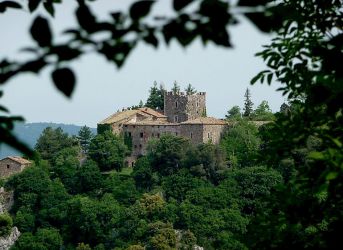Castello di Fosini
The Castle of Fosini is officially located in the municipality of Radicondoli (Province of Sienna) but geographically it is in a part of the territory of Castelnuovo Val di Cecina (Province of Pisa), being situated at the source of the Pavone stream opposite the "Cornata di Gerfalco". The first written evidence of the Castle of Fosini is from the 12 C when the castle was recorded among the possessions of the Bishop of Volterra. Later it became a feif of the Pannocchieschi family, counts of the neighbouring Castle of Elci. Later still, it fell under the sovereignty of Sienna, probably still under the control of the counts of Elci.
The castle has a square keep surrounding a central courtyard. The walls to the south and west, which are largely in ruins, are unrefined structures of stone and brick. The wall to the northwest is better preserved, with a steep-sided base and numerous arrow slits along the lower floor. The interior is closed off by iron grills and cannot be visited. Over the years, vandals and negligence have cause severe damage to the structure. The main tower dominates the valley of the Pavone which is densely forested. There is a belvedere nearby from which one may enjoy this evocative view.
The whole area is a part of the nature reserve of the Cornate (crags) and the Castle. The presence of perpendicular cliffs provides an ideal nesting environment for birds of prey including the peregrine falcon and the lanner falcon. Animals found in the forest include roe deer, fallow deer, porcupines, weasels, polecats and beech martens. The flora includes rare plants such as the Tuscan violet.
The Castello di Fosini also has its ghost. A legend originating in the 14 C has it that one Ilario Brandani, notorious as a necromancer with knowledge of ancient magic spells for calling forth the dead, lived in the castle. He remained the sole living inhabitant, closed up in the castle for years with dozens of corpses and silence of his gruesome company. Anyone who sees his ghost in condemned to join his companions.
The castle has a square keep surrounding a central courtyard. The walls to the south and west, which are largely in ruins, are unrefined structures of stone and brick. The wall to the northwest is better preserved, with a steep-sided base and numerous arrow slits along the lower floor. The interior is closed off by iron grills and cannot be visited. Over the years, vandals and negligence have cause severe damage to the structure. The main tower dominates the valley of the Pavone which is densely forested. There is a belvedere nearby from which one may enjoy this evocative view.
The whole area is a part of the nature reserve of the Cornate (crags) and the Castle. The presence of perpendicular cliffs provides an ideal nesting environment for birds of prey including the peregrine falcon and the lanner falcon. Animals found in the forest include roe deer, fallow deer, porcupines, weasels, polecats and beech martens. The flora includes rare plants such as the Tuscan violet.
The Castello di Fosini also has its ghost. A legend originating in the 14 C has it that one Ilario Brandani, notorious as a necromancer with knowledge of ancient magic spells for calling forth the dead, lived in the castle. He remained the sole living inhabitant, closed up in the castle for years with dozens of corpses and silence of his gruesome company. Anyone who sees his ghost in condemned to join his companions.
Radicondoli © ammonet InfoTech 2007 - 2021. All rights reserved.


